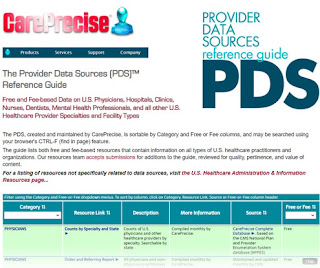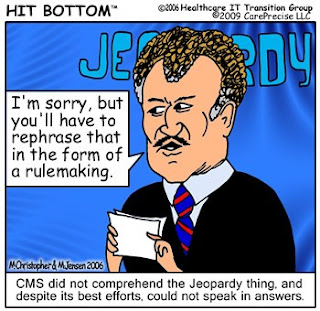It might seem like this is a shameless, self-serving promo for CarePrecise provider data packages. Unsurprisingly, our name does come up a lot when companies stagger away in shock from the prices our competitors charge. But that's not what this post is about. We're going to talk about (mostly) free data.
Hopefully this post will help you find provider data that's available for free from the U.S. government. Using free data you can boost the information value in any provider contact list. If you're working with a helpful data vendor, chances are they'll help you find where you can download particular kinds of data you're looking for. For instance, we have a lot of customers who use our basic hospital database who need additional components that we don't package with the product, but we know where to find them and we're glad to share our knowledge.
Of course, we could pull all of that data into our hospital dataset, but there's SO much out there, and if we did that the product would be very expensive indeed. That database sells for $939 but would be a couple of orders of magnitude pricier with all of just the 70 U.S. hospital data files listed in just one spot on the Centers for Medicare and Medicaid Services (CMS) website.
So, instead of trying to pack everything in, we bring together the hard-to-find/basic-necessity data, and assist customers in finding additional information specific to their particular need. Here are some of our more common recommendations.
When on the hunt for data gold, it can be painfully difficult to locate that needle in the haystack. The screenshot shows the count of the results of a search on the federal data website, data.gov, for "healthcare provider data." 127,500 datasets would be a daunting place to start digging. It's like, "Go get the gold! It's somewhere in that there mountain." Fortunately, we have had some experience with healthcare data excavation, and can often point our customers to pay dirt.
If you have talented data people, a good starting place is the NPPES dataset (National Plan and Provider Enumeration System), which contains about 7.4 million NPI records for individuals and organizations. The download file is much to large to use in ordinary office software, so your team will have to cut it into pieces. Or you can get the full NPPES already processed into a form to be used with Microsoft Office programs from CarePrecise. The CarePrecise product also contains additional data, such as sanctions, and whether or not a practitioner is enrolled to bill Medicare.
Once you have basic data on the providers, you'll want to add linkages between the clinicians and their practice groups and hospital affiliations. You can download the free Physician Compare database and have your tech team work its magic here, too, to make it useable on ordinary office computers. This used to be easier back when CMS included hospital information in the database, but now just to get all the hospital names and basic info you have to ingest ten additional datasets. The list is too big to include here, but highlights include the Licensed and Certified Healthcare Facility Listing where you'll find hospitals' CCN numbers matched to their names and addresses, and Medicare Inpatient Hospitals where you'll find some payment information. You'll want to head on back to CMS to pick up outpatient hospital info. These are just a few of the dozens of datasets we ingest on an ongoing basis to produce our monthly updates. For the datasets we monitor but don't regularly ingest, we're more than happy to help customers dig it up.
Hospital data is a bit easier to find and work with than practitioner data. For instance, the list of U.S. physicians is about 1.1 million doctors long, and that's too big to open in Excel. You'll need to get the physician files into a relational database for them to be very useful. If you're starting from the provider data catalog, you'll see the datasets for hospitals, home health agencies and other kinds of healthcare providers, as well as those doctors and other clinicians. You can also find physicians' CAHPS (patient experience metrics), as well as many of the types of procedures physicians perform.
Perhaps the best advice we find ourselves giving our customers who want to go it alone is to have a crackerjack tech team, or at least one person with a lot of database savvy, and start with buying a basic provider data product that you can use as a data structure template. Most federal data on clinicians is linked to their NPI number, so that's where you'll start building your relational database. Your next step is to talk with whoever sold you your basic data, and ask for help finding any missing components. CarePrecise prides itself on offering most of these, all ready to use, but some customers just enjoy the hunt, and even our most comprehensive data package can't contain everything you might want.
We don't shy away from telling our customers where they can find what they're looking for, even if the only place happens to be one of our competitors. In fact, CarePrecise data is compatible with data structures used across the industry. We even provide the Placekey for almost every record in our products, which connects our data with visitor traffic data and other Point of Interest (POI) products offered by other companies.
Many CarePrecise customers get our extended provider data package. CarePrecise Platinum has those elusive practice group and hospital affiliations, and software that makes it possible to get at exactly what you need without knowing anything about databases. It makes a great starting place for building your own bespoke database.
About Updates
When you're finding and ingesting data, it's important to plan for updates. Some data sources are updated weekly, others monthly or quarterly, and some only on an annual basis. Create a table listing the resources and their update frequency, and build in the necessary automation to re-ingest them regularly. This is especially important if your use case requires up-to-date information. This often overlooked step of building-in updates can be costly to do later on. Best if it's baked-in from the beginning. This includes your ingestion process for data you get from us, which you can automate to import the monthly or quarterly updates. We offer FTP delivery as an option, which can put the data directly onto your server, ready to be ingested by stored procedures that are triggered by the upload of the data, or by the modified date on the files.
If you want some help finding data sources, just speak with your CarePrecise representative. We may already have an affordable solution that will save you many hours of understanding an unfamiliar and often cryptic dataset. If we don't have it, your representative will help you find it.
One quick note... We offer these sourcing services to current CarePrecise subscribers. It would be great if we could open it up to everyone, but we have to keep our focus on our customers.



